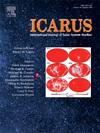Constraining the survival of HCN during cometary impacts
IF 3
2区 物理与天体物理
Q2 ASTRONOMY & ASTROPHYSICS
引用次数: 0
Abstract
Cometary impacts have been invoked as an atmosphere-independent method of stockpiling hydrogen cyanide (HCN), a key prebiotic feedstock molecule, into environments favourable for the onset of prebiotic chemistry on the early Earth. This work revisits the prospects for cometary delivery of HCN through new impact simulations of idealised cometary bodies using the shock physics code iSALE combined with simple chemical modelling. Using temperature and pressure profiles for material within spherical, non-porous comets with a high resolution of Lagrangian tracer particles, we assess the survival rate of HCN across a range of impact velocities, sizes, and angles, assuming both steady state and equilibrium chemistry. We find that HCN survival is extremely limited at impact velocities above the escape velocity of the Earth, unless the impact occurs at extreme obliquity (). We present a parametrisation of the survival of HCN as a function of impact velocity, angle, and cometary diameter, which provides an upper limit to survival in more realistic scenarios to aid with future studies investigating the role of comets in the origins of life. Although successful HCN delivery may be possible in our idealised model, we neglect to consider the effect of atmospheric passage, and our results suggest that delivery alone is not likely to be sufficient for the onset of prebiotic chemistry.
限制彗星撞击时HCN的存活
彗星撞击被认为是一种不受大气影响的方法,可以将氰化氢(HCN)(一种关键的益生元原料分子)储存到有利于早期地球益生元化学发生的环境中。这项工作通过使用冲击物理代码iSALE结合简单的化学建模,对理想的彗星体进行新的撞击模拟,重新审视了彗星携带HCN的前景。利用球形、无孔彗星内部的温度和压力分布,以及拉格朗日示踪粒子的高分辨率,我们评估了HCN在一系列撞击速度、大小和角度下的存活率,假设了稳态和平衡化学。我们发现,在超过地球逃逸速度的撞击速度下,HCN的存活极为有限,除非撞击发生在极端倾角(θ ~ 15°)。我们将HCN的存活参数化为撞击速度、角度和彗星直径的函数,这为在更现实的情况下存活提供了上限,有助于未来研究彗星在生命起源中的作用。尽管在我们的理想模型中,HCN的成功传递是可能的,但我们忽略了大气通道的影响,我们的结果表明,仅传递HCN可能不足以引发益生元化学反应。
本文章由计算机程序翻译,如有差异,请以英文原文为准。
求助全文
约1分钟内获得全文
求助全文
来源期刊

Icarus
地学天文-天文与天体物理
CiteScore
6.30
自引率
18.80%
发文量
356
审稿时长
2-4 weeks
期刊介绍:
Icarus is devoted to the publication of original contributions in the field of Solar System studies. Manuscripts reporting the results of new research - observational, experimental, or theoretical - concerning the astronomy, geology, meteorology, physics, chemistry, biology, and other scientific aspects of our Solar System or extrasolar systems are welcome. The journal generally does not publish papers devoted exclusively to the Sun, the Earth, celestial mechanics, meteoritics, or astrophysics. Icarus does not publish papers that provide "improved" versions of Bode''s law, or other numerical relations, without a sound physical basis. Icarus does not publish meeting announcements or general notices. Reviews, historical papers, and manuscripts describing spacecraft instrumentation may be considered, but only with prior approval of the editor. An entire issue of the journal is occasionally devoted to a single subject, usually arising from a conference on the same topic. The language of publication is English. American or British usage is accepted, but not a mixture of these.
 求助内容:
求助内容: 应助结果提醒方式:
应助结果提醒方式:


